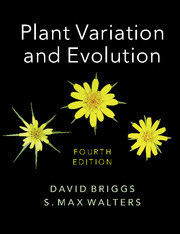Book contents
- Frontmatter
- Contents
- Preface to the Fourth Edition
- Acknowledgements
- Note on names of plants
- List of abbreviations
- 1 Investigating plant variation and evolution
- 2 From Ray to Darwin
- 3 Early work on biometry
- 4 Early work on the basis of individual variation
- 5 Post-Darwinian ideas about evolution
- 6 DNA: towards an understanding of heredity and molecular evolution
- 7 Breeding systems
- 8 Intraspecific variation and the ecotype concept
- 9 Pattern and process in plant populations
- 10 Pattern and process: factors interacting with natural selection
- 11 Populations: origins and extinctions
- 12 Species and speciation: concepts and models
- 13 Allopatric speciation and hybridisation
- 14 Abrupt speciation
- 15 The species concept
- 16 Flowering plant evolution: advances, challenges and prospects
- 17 Historical biogeography
- 18 The evolutionary impact of human activities
- 19 The taxonomic challenge ahead
- 20 Conservation: from protection to restoration and beyond
- Glossary
- References
- Index
16 - Flowering plant evolution: advances, challenges and prospects
Published online by Cambridge University Press: 05 June 2016
- Frontmatter
- Contents
- Preface to the Fourth Edition
- Acknowledgements
- Note on names of plants
- List of abbreviations
- 1 Investigating plant variation and evolution
- 2 From Ray to Darwin
- 3 Early work on biometry
- 4 Early work on the basis of individual variation
- 5 Post-Darwinian ideas about evolution
- 6 DNA: towards an understanding of heredity and molecular evolution
- 7 Breeding systems
- 8 Intraspecific variation and the ecotype concept
- 9 Pattern and process in plant populations
- 10 Pattern and process: factors interacting with natural selection
- 11 Populations: origins and extinctions
- 12 Species and speciation: concepts and models
- 13 Allopatric speciation and hybridisation
- 14 Abrupt speciation
- 15 The species concept
- 16 Flowering plant evolution: advances, challenges and prospects
- 17 Historical biogeography
- 18 The evolutionary impact of human activities
- 19 The taxonomic challenge ahead
- 20 Conservation: from protection to restoration and beyond
- Glossary
- References
- Index
Summary
In a famous section of the Origin Darwin (1859) speculated on the evolution of the variety of organisms. He wrote:
The affinities of all the beings of the same class have sometimes been represented by a great tree. I believe this simile largely speaks the truth. The green and budding twigs may represent existing species; and those produced during each former year may represent the long succession of extinct species … The limbs, divided into great branches, and these into lesser and lesser branches, were themselves once, when the tree was small, budding twigs; and this connexion of the former and present buds by ramifying branches may well represent the classification of all extinct and living species in groups subordinate to groups.
(Darwin, 1859).With regard to the ‘testing’ of this model, in a letter to T. H. Huxley, dated 26 September 1857 he expressed the view that: ‘The time will come, I believe, though I shall not live to see it, when we shall have very fairly true genealogical trees of each great kingdom of Nature’ (Darwin & Seward, 1903).
The devising of phylogenetic trees
Spectacular progress has recently been made in the study of phylogenetic trees from the DNA sequences of living organisms. In order to understand these powerful techniques it is important to consider the historical context in which they developed. But first, we examine the different sorts of classifications that biologists make, and consider the extent to which they might reveal evolutionary pathways.
Classifications
Gilmour (1937, 1940, 1951; Gilmour & Walters, 1963) has stressed that different classifications have been developed for different purposes. Two types of classification may be devised. First, there are the special-purpose classifications, sometimes called artificial classifications, which are based on one or a few characters. Thus, plants may be divided into trees, shrubs and herbs, the characters height and woodiness having been chosen a priori, i.e. before the assignment to class was made. As we saw in Chapter 2, Linnaeus produced a famous classification, his so-called Sexual System based on the number of parts of the flower (the number of stamens and the number of pistils). In this classification species of different families were placed in the same group.
- Type
- Chapter
- Information
- Plant Variation and Evolution , pp. 336 - 381Publisher: Cambridge University PressPrint publication year: 2016



